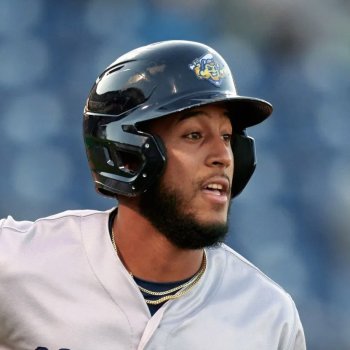WARNE: Pitchers Hesitant to Challenge Patient Sano
Twins Video
t’s hard to envision Miguel Sano rewarding the Twins any more than he has through 18 big league games. The 22 year old has hit .283/.405/.517 in 74 plate appearances, and eight of his 17 hits have gone for extra bases. Strikeouts were always going to be an issue in the short term, and that’s been no exception as he’s fanned in 35.1 percent of his plate appearances so far.
For some context, his 162-game paces according to BaseballReference.com are 27 home runs, 99 RBIs and 234 strikeouts. And considering the MLB record for strikeouts in a single season is 223, by Mark Reynolds in 2009, there is some cause for concern. Just six batters in MLB history have struck out 200 or more times in a season — and they’ve all come between 2008 and now.
But it would be a lot more worrisome if Sano wasn’t also taking plenty of walks. Sano’s current pace is 117 walks over a full season of playing time — a 17.6 percent rate. And while his numbers would surely see some form of regression over a full season worth of play, he’s walking at a present rate that just two big league hitters have sustained as “qualified” hitters. That is, batters who have 3.1 plate appearances per team games played.
Those two batters are Paul Goldschmidt (18.4 percent) and Bryce Harper (18.7 percent). That’s some incredible company.
In this age where average fans have become more and more engaged and aware with what prospects are doing, it’s no surprise that teams have been keenly aware of what Sano is capable of from the get-go. He hasn’t been pitched like a rookie; rather, he’s been pitched like a 10-year veteran, and the incredible thing is that he’s more than held his own.
Here’s some evidence: Fangraphs keeps track of what batters face what pitches, both in terms of frequency and at what velocity. So for instance, among Twins big league regulars, Kurt Suzuki has seen the most fastballs at a 64.6 percent rate. And given Suzuki’s offensive struggles, that makes sense. Joe Mauer is right behind him at 62.6 percent, and it’s clear that opposing pitchers want to see if his bat is still quick enough to keep up with the heat. Given that he’s hitting .277/.339/.394, the jury is still out on that one.
But to scroll all the way down the list brings us to some interesting cases. Demoted designated hitter Kennys Vargas saw fastballs just 51.7 percent of the time, as pitchers tried to — and succeeded — at getting him to chase offspeed and breaking stuff both in and out of the zone. But at the bottom of the list is our subject, Mr. Sano, who has seen fastballs just 48.6 percent of the time.
Manager Paul Molitor isn’t surprised by this. “I think that people have enough contacts in the game to have an idea of how to go about facing him from the first day he got here,” Molitor said. “They still try to get him to expand (the zone) a little bit, whether it’s high velocity of breaking pitches off the plate.” The velocity comment is interesting, and it checks out with the data. No Twins regular is seeing a harder average fastball than Sano at 93.5 mph. Molitor added: “(Sano) hasn’t had a lot of hits as of late, but his at-bats have still been really good.”
One would have to conclude they’ve been remarkably good, given his relative age and level of experience on the game’s grandest stage. Backup catcher Eric Fryer, who was never a teammate of Sano’s in the minors but is well regarded for his defense, game-calling and handling of pitchers, has been impressed by the approach taken by the young hitter. “He’s doing very well,” Fryer said. “Even his walks, you know sometimes you think he’s not doing great, but he had that big walk in Oakland off Sonny Gray that set up Trevor Plouffe’s grand slam which pretty much won the game. Him being disciplined to take pitches when he needs to take ‘em and swing when he needs to is great.”
Fryer’s intel is helpful when considering how pitchers and catchers would like to attack such a young and talented hitter, especially considering how he can also tap into his knowledge as a minor league lifer who has seen how these guys have been handled. “From what I remember from Double-A, there’s definitely more fastballs in fastball counts,” Fryer added. “So I think that’s a big adjustment as you go to Triple-A — which Sano skipped — and the big leagues is being able to see breaking pitches in fastball counts consistently.”
Fryer wasn’t surprised when presented with the numbers regarding Sano being pitched carefully. “I mean, they’ve seen he’s got some pretty good juice. They know it from batting practice,” Fryer said. “I think the word is around he can swing the bat a little bit. So a lot of times when younger guys come up, pitchers — especially veteran pitchers — are going to try and go to their offspeed and see if they can adjust to it. A lot of times, here in the big leagues, you can hit a fastball. It’s just a matter of if you can adjust to it. So I guess what they’re doing — showing more breaking pitches — is to see if he can adjust to offspeed consistently. Once he shows that, they’ll have to change their gameplan a little bit.”
For some added context, if Sano were a qualified batter, he’d rank 161st of 162 batters in terms of fastball percentage, behind Kendrys Morales (48.9 percent) but ahead of just Pedro Alvarez (47.6 percent). He’d also rank first in terms of fastballs seen velocity-wise, ahead of Kris Bryant (93.1 mph). And while obviously there’s wiggle room for those numbers to shake out as he plays himself into a bigger sample size, it does portray a pretty good picture of what pitchers are trying to do to him in the near or short term. To Sano’s credit, he’s also handled offspeed and breaking balls very well. According to BaseballSavant.com — a must-browse if you’re a serious baseball fan — Sano is hitting .345 (10-for-29) on breaking balls and offspeed stuff, another very encouraging sign.
None of this really bothers Sano, however. “Yeah, I don’t see too many fastballs,” Sano told Cold Omaha on Friday. “I try to have a good approach every time. I try to hit the ball hard to right field. I try to work hard every day. That’s what I do.”
Sano’s comments on Double-A match up with Fryer’s recollection of the level. “In Double-A, I saw a lot of fastballs,” Sano added. “A couple years ago before I was hurt, I saw a lot of fastballs. Here I don’t see too many. This is the game, you know? Power hitter. And I try to have a good approach, and try to be healthy. I’m excited to be in the game.”
But is it difficult for Sano to be patient as he tries to take the league by storm with his best tool? Not really, he says. “No, it’s not hard to be patient because I played in Double-A, and a lot of pitchers there are good,” Sano said. “I try to have the same patience I had in Double-A, taking my walks.”
Nobody is more confident in Sano’s ability than he is, as he coolly added, ”If a pitcher makes a mistake and gives me a good pitch, I can hit a bomb or something like that. Or I can take a ball. Here the pitchers don’t make a lot of mistakes. Sometimes they walk me. And I’ll take the walk. Every at-bat I try to take a good at-bat.”
This article originally appeared at Cold Omaha here; please click through to support the content.






1 Comment
Recommended Comments